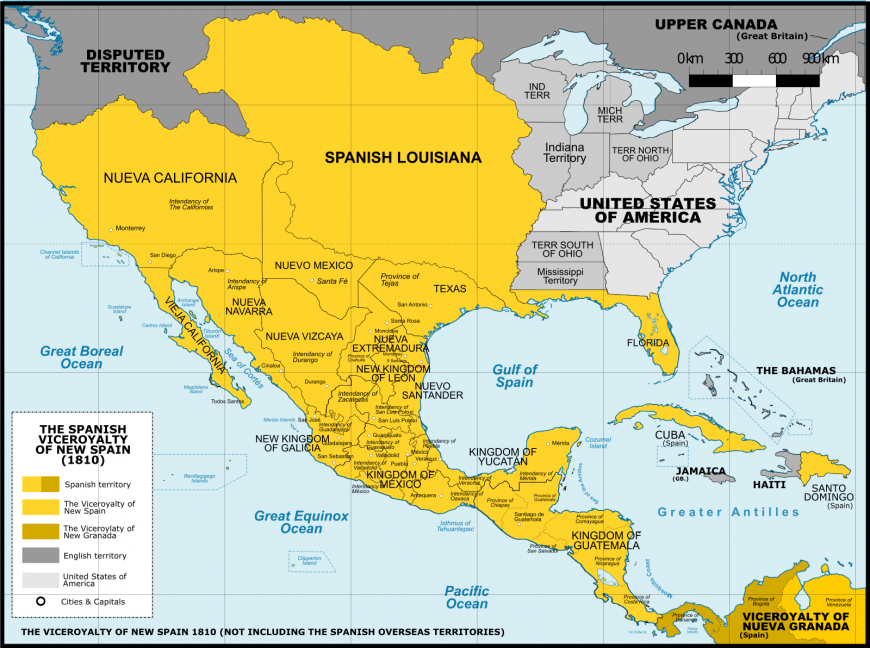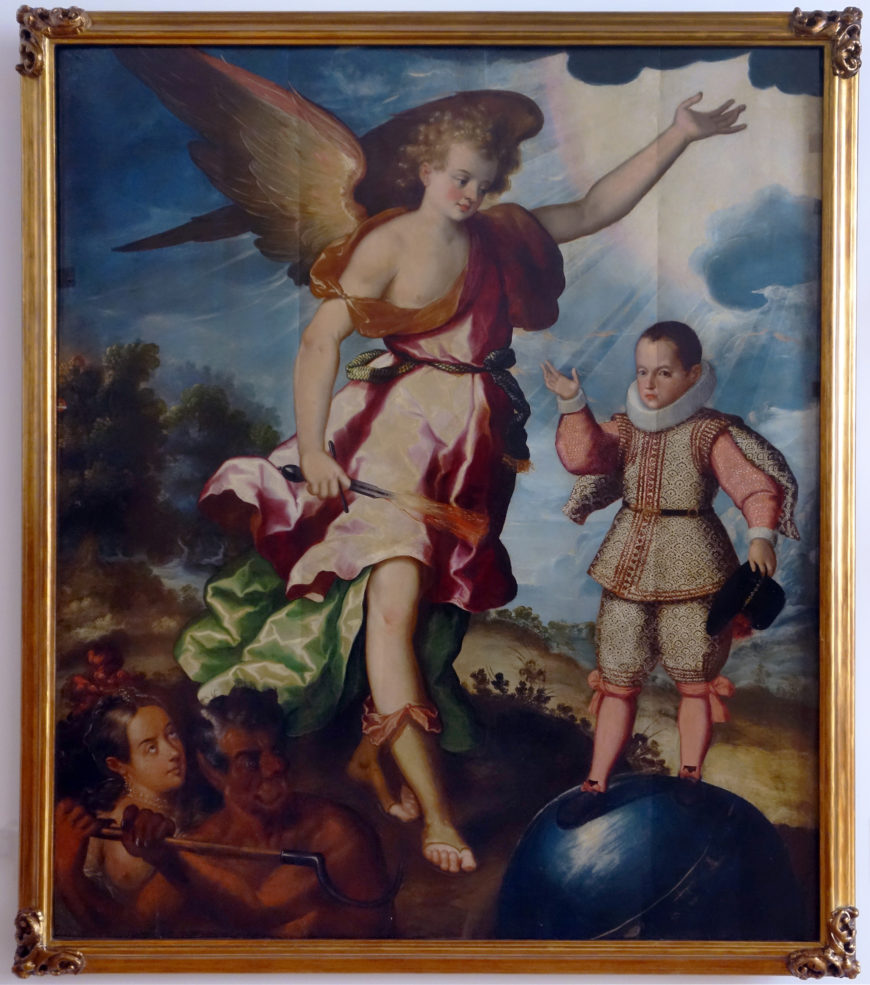
Luis Juárez, The Guardian Angel, early 17th century, oil on wood, 68.3 x 58.66 in (Museo Nacional de Arte, INBA; photo: Steven Zucker, CC BY-NC-SA 2.0)
Guardian angels
Brandishing a fiery sword, standing in a balletic pose, and stretching almost top to bottom in a painting, an angel protects a young boy. His pink and green clothes flutter behind him and his delicately painted wings compliment his golden curls. The boy wears expensive clothing—indicating he is elite, or possibly even royalty—and stands on a blue orb. He gestures toward the angel, as if to acknowledge his divine protector, and in turn the angel makes the same gesture toward the light of God in the upper right. The angel protects the child from the two figures in the darkened lower left corner: a woman with an exposed breast and wearing jewelry (perhaps an allegory of Lust or Temptation), and Satan holding a hook. They look toward the boy, as if to tempt him or catch him in sin. They are the dark to juxtapose the light streaming from the opposite, diagonal corner. In this painting, by the artist Luis Juárez in New Spain, the guardian angel protects the noble child from evil.
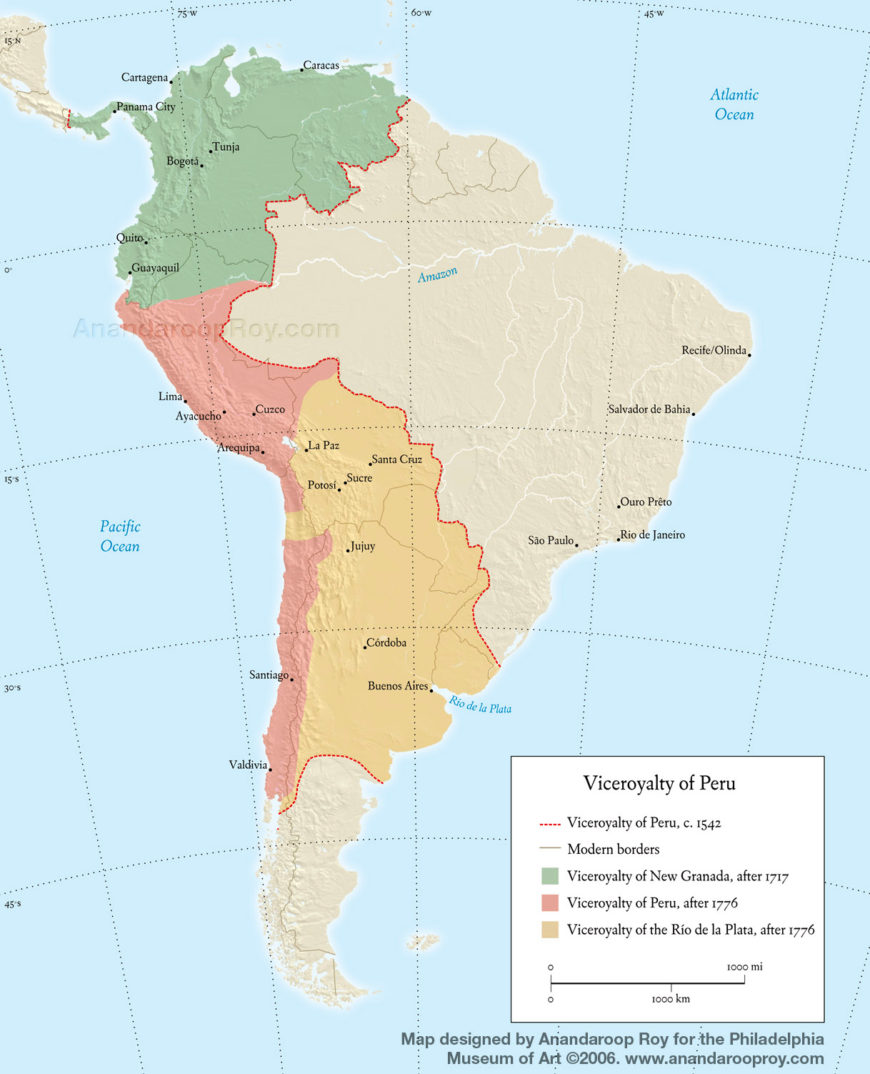
Map showing the Viceroyalty of Peru; early boundaries demarcated in red. The viceroyalty of Peru would eventually be split up into three separate viceroyalties in the 18th century.
The theme of protection, or more accurately, protection of Christians and the Christian faith, was common in the Spanish viceroyalties of New Spain and Peru (and eventually the viceroyalties of New Granada and Río de la Plata). Painted around 1615, the subject of Juárez’s painting can be understood in relation to several important historical events. To begin, about a hundred years earlier (as the invasion and colonization of the Americas was still in its early phase in the early sixteenth century) the Catholic Church split after the Protestant Reformation erupted in northern Europe. For much of the next century, the threat of Protestantism loomed large, which caused reforms in the Catholic Church that were decided at the Council of Trent which convened between 1545–63. The powerful Ottoman Empire continued to be cause for concern among many European Christians as well; the Ottomans represented a powerful Muslim empire and had already defeated the Byzantine Empire (among others). Even with the perceived threats to Catholicism, the Catholic Church remained tremendously powerful and exerted its influence across the globe. In Europe, images of angels as protectors became more common during the Counter Reformation (the Catholic Church’s response to the Protestant Reformation) as did other depictions of saints who defended the Christian faith from supposed heretics, infidels, and invaders.
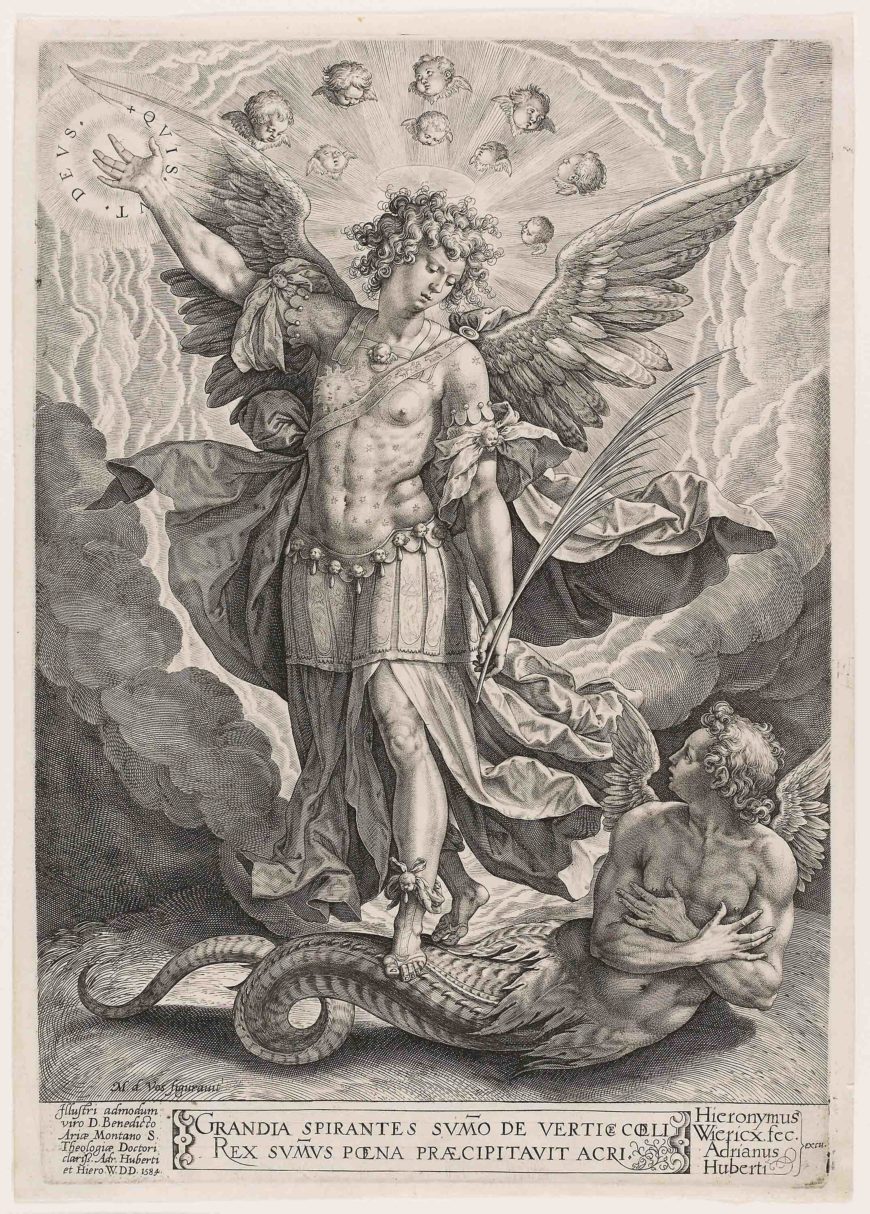
Jerome Wierix after Martin de Vos, St. Michael Triumphing Over the Dragon, 1584, Engraving in black on ivory laid paper,
291 × 202 mm (Art Institute of Chicago)
Ideas about heretics and infidels, as well as the subjects of heavenly protectors, arrived in the Americas with Spanish colonization. The subject of heavenly protectors not only communicated the same messages, but also conveyed new meanings in these newly colonized lands. The defense of the Church and the protection of Christians had a particular urgency as mass forced conversions occurred, as millions of Indigenous people and entire continents came increasingly under the control of Euro-Christian forces. The desire to convert Indigenous peoples to Christianity seemed especially urgent because many Christians believed the Second Coming of Christ and Judgment Day would occur soon—and when that happened, any unbaptized souls would be condemned to suffer for eternity.
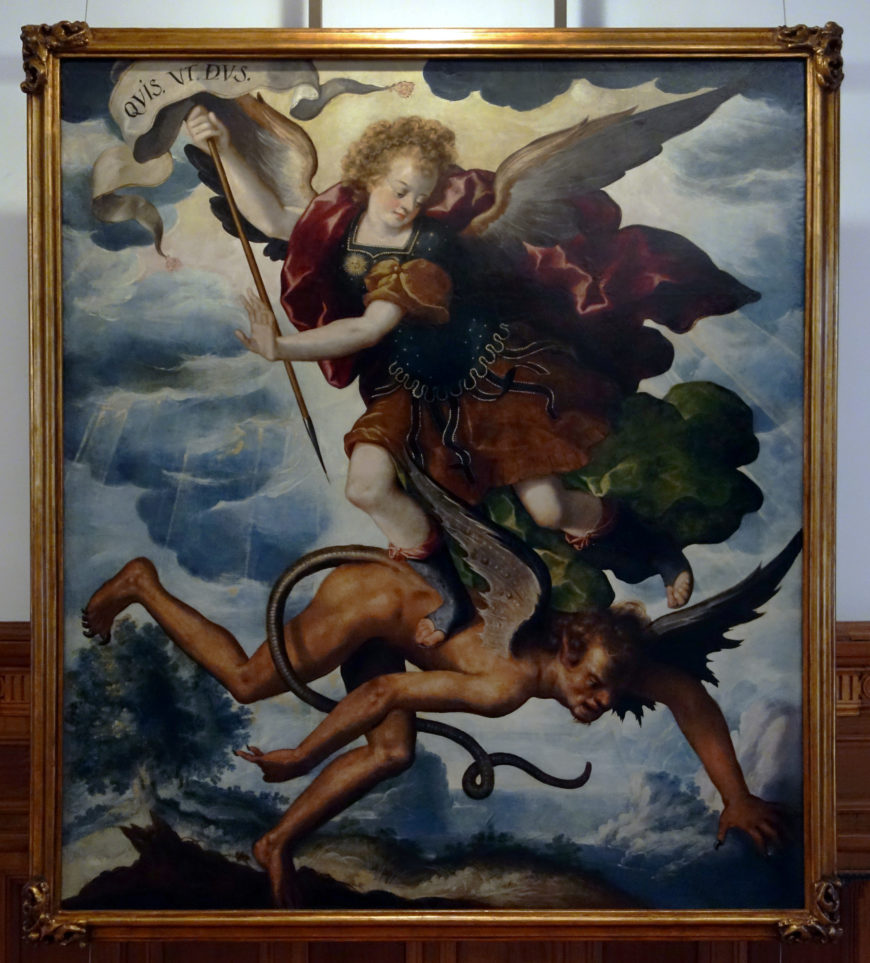
Luis Juárez, Saint Michael the Archangel, early 17th century, oil on wood, 175 x 153 cm (Museo Nacional de Arte, INBA; photo: Steven Zucker, CC BY-NC-SA 2.0)
St. Michael the Archangel
Besides images showing guardian angels, another popular subject was St. Michael the Archangel. Paintings, prints, and sculptures of St. Michael as a defender of the faith were common across the Spanish Americas. In many instances, Michael is shown in Roman military clothing standing atop Satan, who falls face forward toward the ground. In another painting by Juárez, Saint Michael the Archangel, Michael poses triumphantly on Satan’s back, holding a spear (topped by a banner) angled towards the Devil. The painting calls to mind the Book of Revelation (chapter 12), in which Michael defends the Woman of the Apocalypse (understood by Christians to be the Virgin Mary). Rays of divine light illuminate Michael from above, giving the impression of light battling darkness yet again. Here, Michael is a symbol of the Church Militant (the idea of the church battling against heresy and sin). Michael was understood as protecting the expansionist agenda of the church, which amounted to supporting European colonialism and the conversion of the Indigenous peoples of the Americas. This painting was possibly paired with the one of the Guardian Angel above.
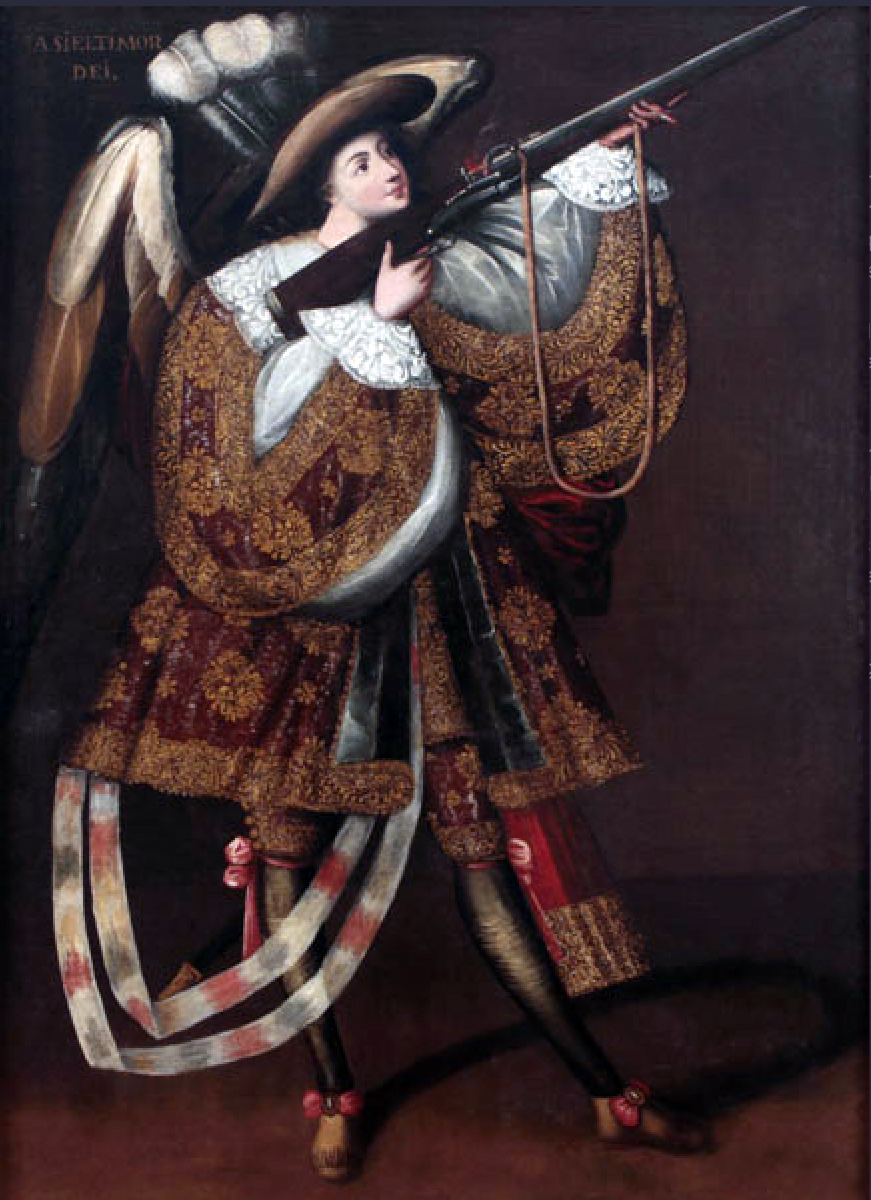
Master of Calamarca, Archangel with Gun, Asiel Timor Dei, before 1728, oil on canvas and gilding, 160 x 110 cm (Museo Nacional de Arte, La Paz, Bolivia)
Armed angels
The idea of militaristic angels spawned new art forms in the Spanish Americas. In the viceroyalty of Peru (in what is today Bolivia), a genre of painting now called ángeles arabuceros (or harquebus-holding angels — a harquebus is a type of gun) developed. In one by the Master of Calamarca, we see an angel wearing elaborate clothes and accoutrements—enormous puffy sleeves, fanciful and delicate lace, golden embroidery, and a hat topped with feathers. Its body is almost lost underneath all the fanciful clothes, but its graceful legs stand firmly on the ground. The angel holds a harquebus aiming it toward the upper right corner. One of the messages of the painting is that the angel defends Christians, supported by the inscription “Asiel Timor Dei” (Asiel Fear of God).
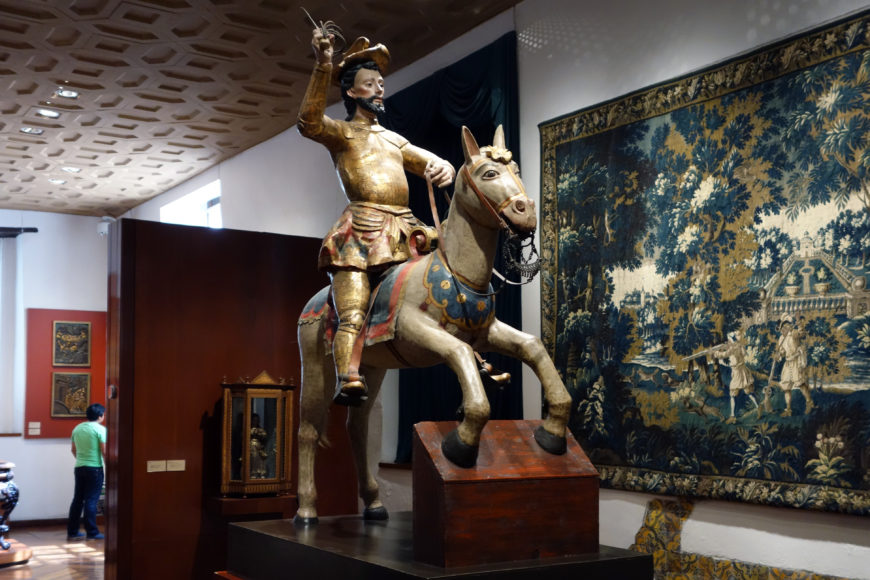
Santiago on Horseback, 16th century, polychromed and gilded wood (Museo Franz Mayer, Mexico City, Mexico; photo: Steven Zucker, CC BY-NC-SA 2.0)
Saint James (Santiago)
Saint James (Santiago in Spanish), the patron saint of Spain, was another defender of the faith who was popular in the Spanish Americas. He was often displayed on horseback, brandishing a sword. In one polychrome (painted) and gilded wooden sculpture from central New Spain, Santiago sits on a horse. Realistic elements like stirrups, hair, and leather make the sculpture seem more realistic. This type of sculpture is called a paso, and it was meant to be carried or even wheeled during a religious procession. For instance, it would have been processed on Saint James’s feast day in July. Underneath the horse’s feet is an empty box, but originally would have included figures painted on it (either Muslims or Indigenous peoples) to give the illusion that the horse was trampling them (perceived as enemies, heretics, and pagans).
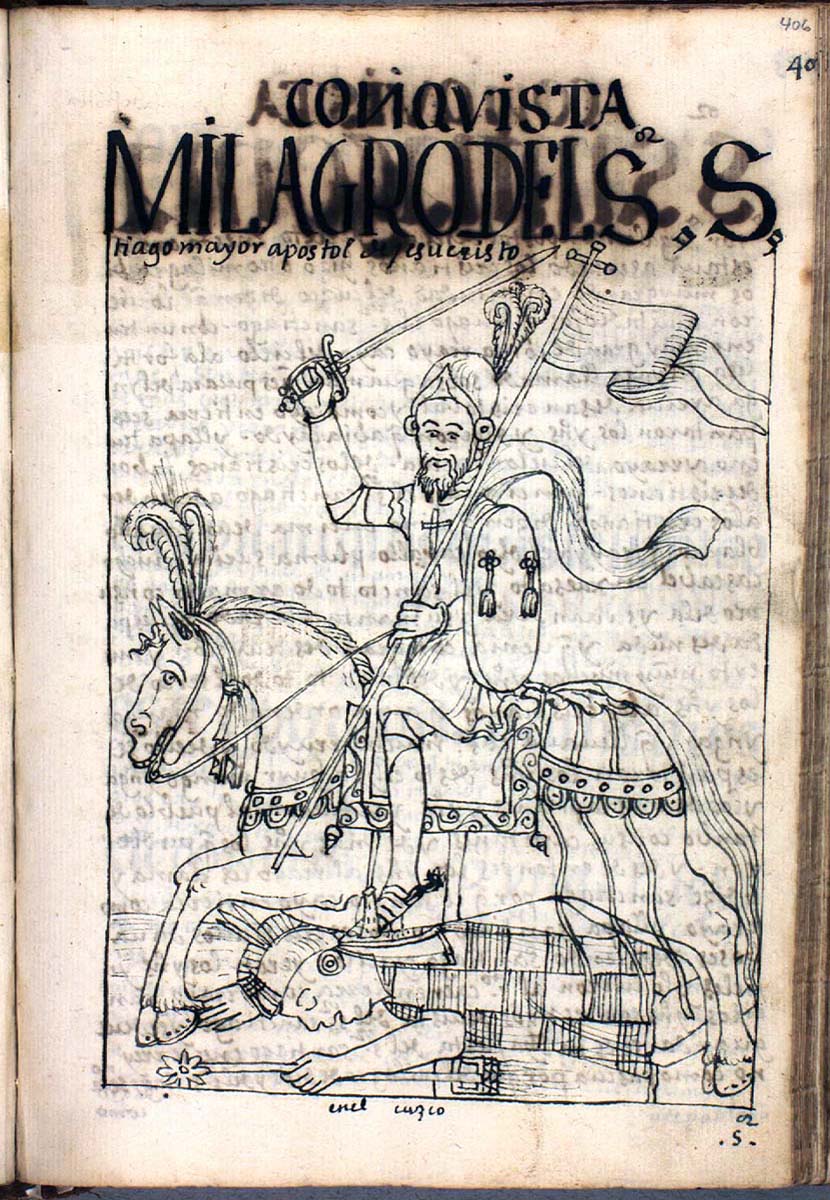
“St. James the Great, Apostle of Christ, intervenes in the war in Cuzco.” Page 406v from Felipe Guaman Poma de Ayala, The First New Chronicle and Good Government or El primer nueva corónica y buen gobierno, c. 1615 (The Royal Danish Library, Copenhagen)
Santiago’s popularity in Spain dates back to the 8th century when he miraculously came to the aid of Christians fighting Muslims on the Iberian Peninsula (today, Spain and Portugal). His bodily remains were also popular relics in northwestern Spain in Compostela and many medieval pilgrims made journeys to venerate them. In Spain, he was often represented as Santiago Matamoros, or Saint James the “Moorslayer”—literally as someone who kills Muslims.
This trope as defender of Christians also came to the Americas, where he was sometimes understood and shown as Santiago Mataindios, “Saints James the slayer of indios.” He is also credited with fighting for the Spanish conquistadors against Indigenous peoples. In one well-known apparition, Santiago helped Spanish forces during a battle in Cuzco in 1536 when he appeared on a white horse with a sword to defend them against the Inka. As a result, he soon appeared through the viceroyalties as a defender of Christians and as a sign of triumph. Native Andean author-artist Felipe Guaman Poma de Ayala illustrated the event in his letter to the King of Spain, showing Santiago on horseback and trampling an Inka warrior. Interestingly, some Indigenous peoples venerated Santiago, which may seem contradictory. For some Indigenous Andeans, he came to be associated with Ilapa (a deity of lightning and thunder), demonstrating the complex ways in which Catholicism was transformed, nuanced, or altered after the Spanish Conquests.

Saint Christopher and the Christ Child, 16-17th century, polychromed wood (Museo de Arte de Sacro, Cuernavaca, Mexico)
Saint Christopher
Saint Christopher is another protective saint who was popular in the Spanish Americas. He is often shown carrying the Christ Child to demonstrate his care of Christians, such as we see in another Novohispanic (from New Spain) polychrome and gilded wooden sculpture. The saint has well-developed musculature, and he dwarfs the young child who sits upon his shoulders. Christopher was known as the cristo ferens, or Christ bearer. He had devoted himself to the teachings of Jesus, and in doing so began to ferry people across the river on his shoulders. One day, he carried a child across the river, but with each step the Child grew heavier and the ferrying grew more challenging. Once on the other side of the river, the Child identified himself as Jesus and told Christopher he had just carried the weight of the world on his shoulder (this is also why Christopher is the patron saint of travelers).
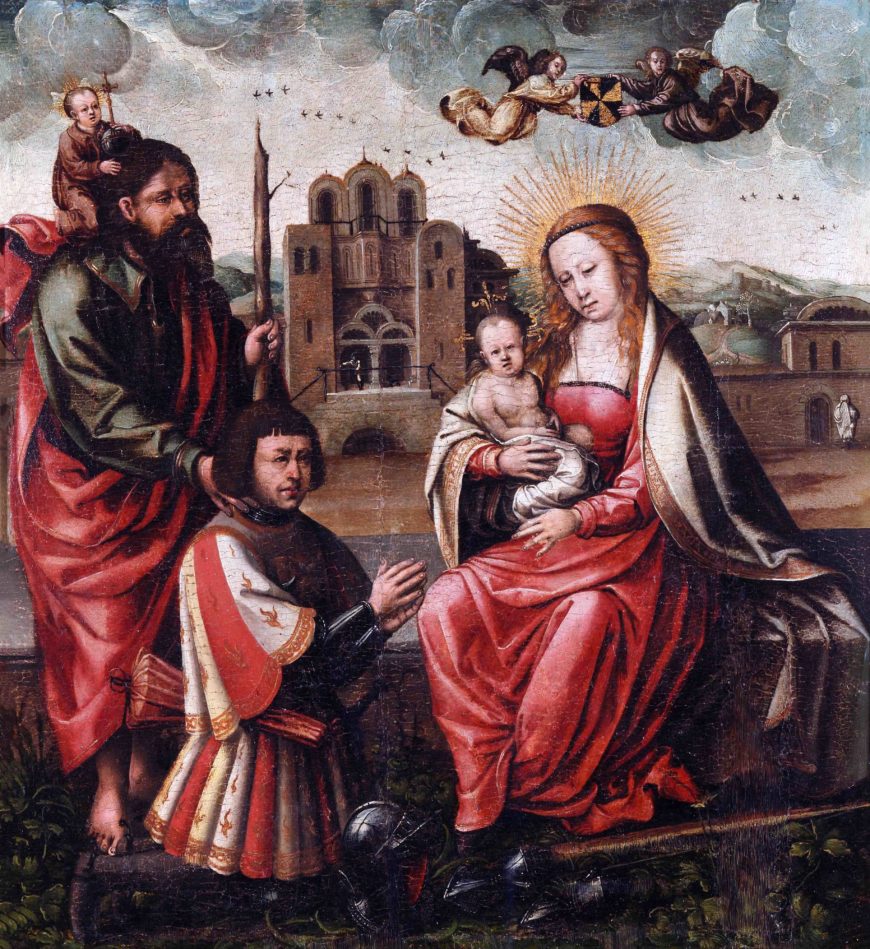
Virgin of Christopher Columbus, oil on panel, first half of the 16th century, 20 x 18 inches (Lázaro Galdiano Museum, Madrid)
Christopher was a popular saint in the Americas because he also symbolized the carrying of Christianity across the Atlantic. In a painting from the first half of the 16th century, Christopher Columbus kneels before the Virgin Mary and Christ Child in Hispaniola. Christopher (with Christ upon his shoulder) places his hand on the back of Christopher Columbus to demonstrate his divine protection and to indicate that Columbus was himself another Christ bearer—his voyages initiated the waves of European invasion and colonization that would occur in the Americas after 1492.

Main altar with Saint Michael the Archangel, Shrine of San Miguel del Milagro, Tlaxcala, Mexico (photo: Isaacvp, CC BY-SA 4.0)
None of these protector saints were unique to the Spanish Americas, but they did acquire new meanings when they traveled from Europe across the Atlantic Ocean. Some of them, such as Saint Michael, would even appear miraculously on American soil (such as at San Miguel del Milagro in Mexico), prompting pilgrimages to sites of these saints’ miraculous apparitions. With these apparitions new local manifestations of these protective saints developed, attesting yet again to the ways in which Catholicism transformed and developed on American soil.

